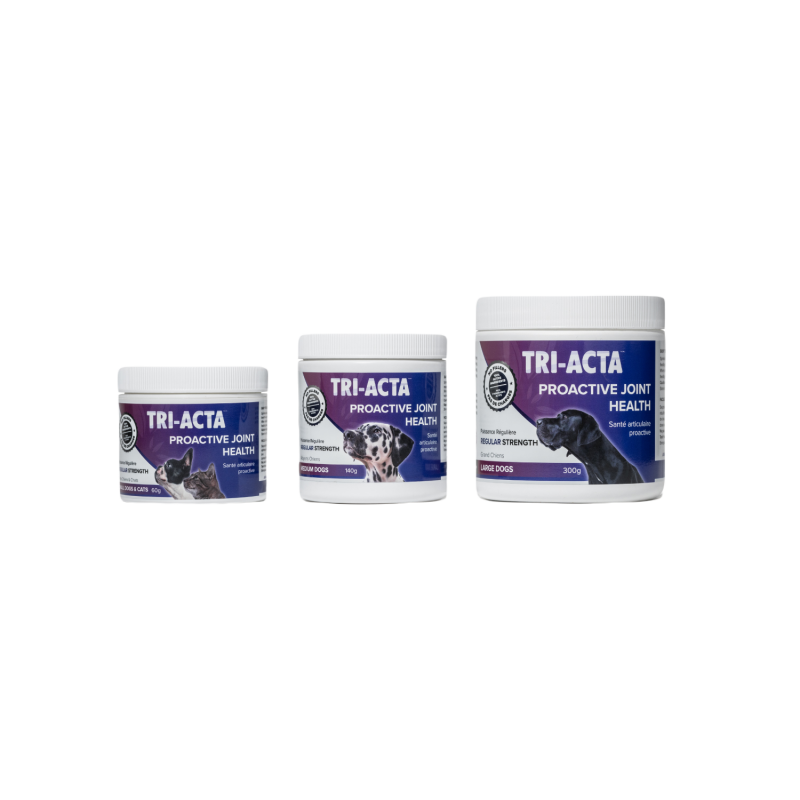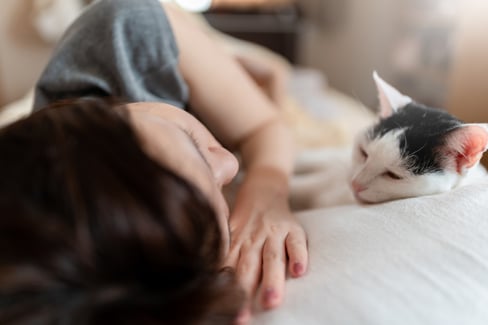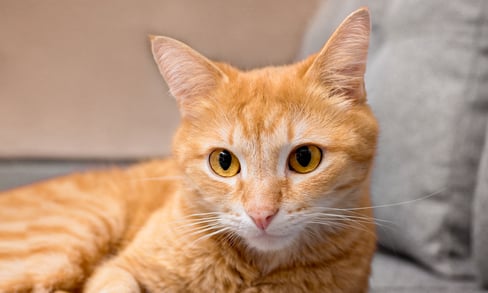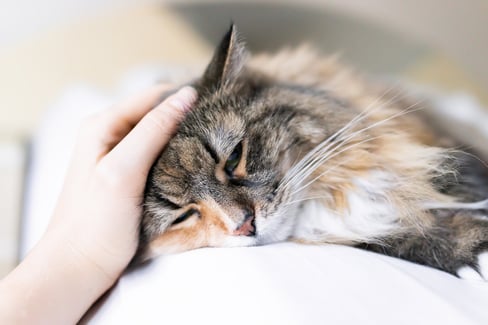Table of Contents
Inflammation is the body’s natural response to injury and the presence of disease-causing bacteria, viruses, or irritants.
Inflammation in itself is not entirely a bad thing. When a cat’s body detects pathogens, the immune system releases white blood cells, which fight off the infection through chemical processes that increase blood flow and tissue fluid into the affected area. This response results in the physical appearance of swelling, redness, or tenderness of the affected region.
With that being said, it’s important to understand inflammation and how it can affect your cat's health. When it goes unchecked, inflammation in cats can lead to other potentially chronic ailments like arthritis, Inflammatory Bowel Disease (IBD), and more.
In this article, we take a deep dive into understanding cat inflammation, its potential causes, effects, and cat anti-inflammatory remedies. We will also give tips on how to comfort your kitty as they recover from inflammation-related pain.
Causes of Inflammation in Cats
Your cat may suffer inflammation due to several environmental triggers, including food, supplements, medicine, or other allergens. It is important to keep an eye out for symptoms of inflammation and pain in your cat.
Let us look at some of the most common inflammation causes in cats:
Allergies
A cat’s immune system can overreact or become hypersensitive to foreign proteins called allergens. Allergic reactions in cats can result in gastrointestinal tract irritation, itching and inflammation of the skin, difficulty breathing, watery eyes, runny nose, vomiting, and diarrhea.
Cat allergies can be categorized in three ways:
- Food allergies and intolerance. The most common food allergens for cats are chicken, pork, and turkey. These types of allergies often occur after a long time of exposure to the allergen. On the other hand, food intolerance is an adverse reaction to an ingredient or component in the food or an additive. For example, most adult cats are lactose intolerant.
- Atopy. This is an allergic reaction to environmental allergens like pollen, mildew, and grass. It results in itchiness, scabs, and hair loss in the affected area.
- Contact allergies. These are allergies that present when the cat comes into direct contact with the allergen. An example is an allergic reaction to bedding material or a type of grooming product like shampoo.
Diseases
The immune system is designed to protect the body against infections and disease-causing pathogens. However, this defense system can sometimes become hyper-defensive and attack healthy body cells. This often results in your furry friend developing autoimmune diseases like Lupus.
Other diseases that result in inflammation include:
- Cat arthritis
- Pancreatitis
- Inflammatory Bowel Disease (IBD)
- Lymphoma
- Conjunctivitis
Excessive Weight Gain / Obesity
The dangers of obesity in cats cannot be understated. Obesity and high-fat levels predispose cats to various health problems like inflammation, insulin resistance, diabetes, skin diseases, and even lameness. In addition, excess weight leads to joint degeneration and the onset of osteoarthritis, which can cause chronic pain in a cat’s body.
Consequently, your cat gets caught in a vicious cycle of pain and inflammation. It is important to monitor your cat's weight gain and ensure that they maintain a healthy body weight. If your cat is already overweight or obese, there are steps you can take to help them shed the excess weight.
Always consult with your veterinarian before embarking on any dietary intervention measures for your overweight cat.
The vet will assess your cat's health status and recommend interventions like:
- Reducing your cat’s calorie intake and food portion. Keep food out of the reach of your cat (except for designated meal times) to prevent overeating and indulgence.
- Designing an age-appropriate diet for your cat, including introducing low-calorie food options. This ensures your furbaby gets the proper nutrients to support healthy growth and body weight.
- Increase your cats’ exercise activities. You could invest in toys encouraging your cat to move around more
- Choose designated meal times. This way, your cat knows that food will be available at specific times only.
Long-Term Effects from Cat Inflammation
Untreated inflammation in cats can lead to other severe conditions like septic shock (Sepsis), cancer, organ failure/dysfunction, the collapse of vascular vessels, and even loss of limbs in the case of cat joint pain and inflammation-related sepsis.
|
Condition Caused by Untreated Inflammation In Cats |
Symptoms |
|
Sepsis |
|
|
Cancer |
|
|
Organ failure |
|
|
Vascular collapse |
|
|
Cat joint pain |
|
If your cat could potentially be suffering from any of the above conditions, it’s important to take them to a veterinarian as soon as possible. Your vet will examine your cat and run tests (such as blood and urine) to determine the cause of the symptoms, and recommend a course of treatment.
Types of Cat Anti Inflammatories
These are medications used to reduce swelling and pain resulting from inflammation. Cat inflammation can be treated in several ways, including:
- Anti-inflammatory cat food
- Supplements
- Anti-inflammatory medication
Anti Inflammatory Cat Food
Reduced inflammation means reduced pain, swelling, and discomfort for your cat. The unique formulation of anti-inflammatory cat food is designed to help cats combat inflammation caused by conditions such as IBD, joint problems, chronic gut infections, and skin diseases. If your cat suffers from severe inflammation from food allergies, your vet might suggest switching to hypoallergenic cat food or introducing a limited ingredient diet (LID) for your kitty.
Hypoallergenic food (Anti-inflammatory cat food) is cat food whose allergy-causing protein has been broken down further. This disguises it from the cat's immune system averting an allergic reaction.
Anti-inflammatory cat food is specially manufactured to help cats suffering from different ailments. This kind of food focuses on incorporating more natural ingredients and limiting or avoiding highly processed ingredients that might have allergens.
Cat Mobility Food
In addition to hypoallergenic cat food, there is also cat mobility food. This is a cat food that is formulated to support and improve joint function in adult and senior cats. This food is often fortified with omega-3 fatty acids, turmeric, glucosamine, and chondroitin to support joint health. Components like Glucosamine and chondroitin promote cartilage regeneration and maintain healthy joints. It is also prescribed for cats suffering from osteoarthritis and mobility problems.
However, to deliver effective therapeutic dosages of glucosamine and chondroitin, cats would need to feed more of the unique mobility food. This is because the food often contains lower quantities of glucosamine per kg. For example, most top cat mobility foods have about 120-150mg of glucosamine per 1 kg of food compared to supplements like TRI-ACTA, which contain 500mg of glucosamine per gram.
TRI-ACTA H.A. for Pets
Our maximum strength formula is optimally designed to accelerate the formation of cartilage, minimize inflammation, expedite the healing process, and improve joint conditions.

Cat Joint Supplements
These are used to promote healthy joints and mobility. They also help alleviate inflammation and joint pain caused by chronic ailments such as DJD and arthritis. For a cat joint supplement to be effective, it should contain the following key ingredients:
- Glucosamine
- Chondroitin sulfate
- MSM
- Hyaluronic acid
Glucosamine is great at repairing cartilage, while chondroitin sulfate works to deter the deterioration of the cartilage in limb joints. MSM is a known anti-inflammatory, antioxidant and pain relief component. While hyaluronic is great at lubricating joints and maintaining healthy synovial fluid.
Here are a few examples of joint supplements that can help alleviate joint inflammation and support cat joint mobility
|
Joint Supplement Name |
Description |
Price |
|
TRI-ACTA H.A. for pets is a great cat joint supplement containing 100% active ingredients with scientifically proven high efficacy and therapeutic levels. |
Price starts at CAD $27.99 |
|
|
Contains the potent anti-inflammatory component Curcumin to support a healthy immune system response and joint health |
Price starts at CAD $44.95 |
|
|
Contains Glucosamine HCL, chondroitin, and MSM for joint health and support. It also contains turmeric powder for an anti-inflammatory effect. |
Price starts at CAD $39.99 |
* Pricing as of January 2023.
Cat Anti-Inflammatory Medication
Non-steroidal Anti-inflammatory drugs (NSAIDs) are commonly used to reduce swelling and the pain associated with inflammation.
Though NSAIDs are effective in pain and inflammation management, no NSAID has been approved for long-term use in cats. This is mainly because they have serious side effects on cats and are only approved for use in the short term and intermittently.
Some of the side effects of NSAIDs in cats include:
- Renal failure
- Gut irritation and diarrhea
- Loss of appetite
- Vomiting
- Lethargy
- Can lead to death if inappropriately prescribed.
Some of the NSAIDs that can be used on cats under vet prescription include:
- Meloxicam. Offered as a once-off pain relief medication. It can be administered as an injectable or in liquid form. More than one dose of this drug has been linked to feline kidney failure and death.
- Robenacoxib. Works well for a majority of cats. However, cats prone to NSAID allergic reactions can exhibit common NSAID side effects, including yellowing of the gums and skin, infection and bleeding from the surgical incision, urinary difficulties, and even seizures.
If you notice your cat exhibiting any of the above symptoms, stop using the medication immediately and contact your vet. In addition, never give human pain medication to your cat, as many human pain medicines are poisonous and can lead to death.
Some alternative medications to NSAIDs (aside from cat joint supplements) include:
- Opioids. These are pain relievers that are used to manage acute pain in cats. Though previously linked to causing mania in cats–caused by the wrong dosage–their reversibility makes them suitable for pain management. Like all drugs, opioids have side effects, too, like blurred vision or mydriasis.
- Corticosteroids. These are naturally occurring steroid hormones produced by the adrenal glands. Corticosteroids have potent anti-inflammatory properties that make them ideal for treating allergies and inflammatory conditions such as osteoarthritis, leg sprains/strains, and autoimmune disorders. The long-term use of corticosteroids has adverse side effects on cats, including renal failure, increased infections, muscle weakness, and predisposition to diabetes.
Additional Treatments for Cat Inflammation
If you are worried about side effects your cat can potentially get from using cat anti-inflammatory medication, you can explore alternative treatment options. We have put together a list of non-medicinal interventions that have been proven effective in treating cat inflammation.
As is with all kinds of treatments meant to relieve cat pain and inflammation, ensure that you keep your vet in the know. From their assessment, your vet will advise on which option best suits your cat.
Laser Treatment
Veterinary laser therapy is a non-invasive procedure done on cats to reduce inflammation and pain caused by diseases like arthritis, Degenerative Joint disease (DJD), soft tissue, ligaments, muscle, and tendon injuries. Laser therapy is great for treating inflammation because it is a pain-free procedure that does not require your cat to be sedated or have it’s fur shaved off to access the pain region.
One other pro of laser treatment is the time it takes to do the procedure. For a once-off treatment of an open wound or laceration, it can take between 3-8 minutes to complete the laser therapy pain relief procedure. Though for more severe conditions, your cat may require several follow-up appointments. Laser therapy is highly effective, and you can expect to see signs of improvement in your cat within 24 hours following the procedure.
Benefits of using laser therapy include:
- Expedite healing and pain management post-surgery
- Faster cell growth and repair after the procedure
- No known side effects. The procedure is considered safe and risk-free
- Reduces formation of scar tissue
- Faster recovery time
- Improves metabolic activity and nerve function
Laser therapy may not entirely cure your cat. It is often used with other treatment remedies, like incorporating dietary cat supplements for maximum benefits.
Laser therapy is affordable for once-off treatments. However, the costs can quickly add up if your cat requires multiple sessions.
Acupuncture
Cat acupuncture borrows from the ancient Chinese procedure used for pain relief by inserting tiny needles into specific pressure points in the body to alleviate pain and inflammation. Cat acupuncture stimulates acupoints or nerve centers to release pain-relieving chemicals called endorphins.
Acupuncture is a painless procedure (when done correctly) and does not cause discomfort to your cat. It has a calming effect, and you might be surprised to see your furbaby grab a quick catnap during the procedure.
Depending on your cat's condition and health status, the acupuncture session can last between 20-60 minutes. There are several ways the therapist can perform acupuncture on your cat:
- Using traditional needles and rotating them on the pressure points
- Using lasers. These are filled with sterile fluids that are injected into the body
- Using electricity to send short bursts of electrical current to stimulate the pressure points
Benefits of acupuncture:
- Doesn't require sedation of your cat
- Reduces stress in cats by lowering cortisol levels and tempering behavioral disorders
- It has no known side effects
- Treatment sessions are relatively short with immediate signs of relief
- Boosts immune system by stimulating blood flow to tissue cells
Cats are relatively tolerant of acupuncture sessions because it is a painless procedure. You can always keep your furbaby company during the sessions if it helps them stay calm.
Natural remedies
You may also desire a more holistic approach to treating your cats’ inflammation. Natural remedies consist of naturally occurring anti-inflammatory components that can be extracted from plants or animal sources.
Natural remedies for treating cat inflammation include:
- Turmeric contains a potent anti-inflammatory component known as curcumin. But curcumin is not just an anti-inflammatory ingredient. It also has anticancer, antiviral, antifungal, and antioxidant effects.
- Glucosamine and Chondroitin are naturally occurring components often found in joint supplements. Glucosamine promotes cartilage growth and regeneration, while chondroitin sulfate inhibits cartilage degeneration. This keeps joints lubricated and healthy alleviating pain caused by diseases like arthritis.
Supplements like TRI-ACTA contain pure quantities of both components (glucosamine HCL and glucosamine sulfate). This makes the supplement suitable as a natural remedy for joint-induced inflammation.
- Omega-3 fatty acids contain Docosahexaenoic acid (DHA) and Eicosatetraenoic acid (EPA), which have an anti-inflammatory effect on your cat's body and support a healthy nervous system. A good source of omega-3 fatty acids is fish oil. However, if your cat is allergic to fish and fish products, hemp seed oil is also a good source of healthy omega-3 acids.
Comforting a Cat in Pain
Cats are good at masking pain. Their predator nature doesn't allow them to show signs of discomfort outwardly. How do you comfort a cat in pain cat is in pain when you can't tell that they are in pain? Fortunately, there are telltale signs that indicate that your cat is in pain and discomfort, including:
- Lameness or difficulty walking
- Difficult or labored breathing
- Excessive licking of the affected area
- Increased vocalization
- Restlessness
- Loss of appetite
- Unwarranted aggression when handled
- Lethargy and excessive sleeping
- Withdrawal from activities
A cat can be in pain as a result of injury, disease or effects of age, trauma or poisoning. When a cat experiences any of these occurrences resulting in inflammation, it is always accompanied by pain and discomfort.
We have discussed ways of treating cat inflammation above, and the remedies readily apply in treating pain in cats. In addition to these anti-inflammatory treatment options, you can do the following to further help your cat and comfort them as they recover:
- Massage can help with blood circulation and promote faster healing
- Heat and cold therapy reduces inflammation and pain. It also enhances blood circulation in the affected area
- Make the home areas easily accessible. Provide steps or ramps around your cat's favorite spots to help them get around with ease
- Physical therapy can help your cat recover from surgery or injury. It can help alleviate pain and regain mobility and use of affected are
Conclusion
Cats make wonderful pet pals because of their reliable warm nature. So it can be stressful to watch them in pain and not know how to help them. We believe that you found the information in this article useful.
Remember to always be on the lookout for signs of inflammation or pain in your cat, as mentioned in this article. Don't let the occasional evasive behavior of your bossy feline prohibit you from constantly checking them out physically to ensure they are okay.
Keep all your vet appointments, and don't hesitate to contact your veterinarian if you have concerns about your cat's health. Discuss your concerns with them, and don't be afraid to bring up any questions you might have concerning your kitty's health.
Finally, maintain a balanced diet, use proactive joint supplements like TRI-ACTA, and ensure that your cat gets lots of fresh water and exercise to stay fit.
TRI-ACTA for Pets
A proactive approach for developing and younger adult pets to maintain optimal joint health mobility, minimize inflammation and fend off age-related ailments.

Don't forget to visit our cat resource page for more information about cat joint care.
Newsletter Signup
Subscribe to our newsletter to receive the latest news and exclusive offers.
.jpg?height=2000&name=Cliick_Integricare-DISPLAY-REVISEDV2%20(1).jpg)
Proactive & Therapeutic Joint Supplements
When given daily, Integricare joint supplements recover bone and joint injuries faster and help prevent mobility injuries from happening in the first place.










